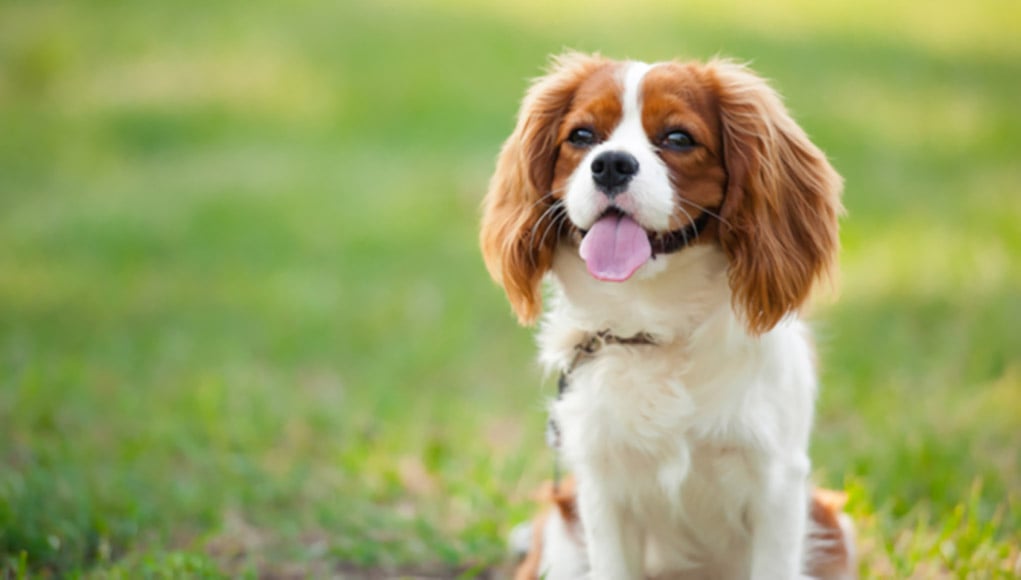Table of Contents
Beauty, gentle and sweet. These are the three words I’d use to describe a Cavalier King Charles Spaniel.
Since then, in 1962, British breeders have been challenged to bring back a royal breed near its extinction. Since breeding such a return is demanding, it wasn’t always successful.

Around the time Charles II passed away in 1685, the disappearance of the long-muzzled Spaniels followed as well.
As trends from Asian breeds, such as the Pug and Japanese Chin, became more prominent in this era, breeding the reference Spaniel by Rosewill Eldrige became more difficult.
However challenging it was, another attempt was made by Judith Blunt in the early 1900s. To recreate the original breed, they utilized the Toy Trawler Spaniels, which they believed was the origin of the royal breed.
Four dogs entered the particular class adjacent to the King Charles Spaniel breed but still weren’t close to the royal breed despite the failed attempts.
As time passed, fellow breeders took their time breeding King Charles Spaniel more carefully.
In 1928, a male named Ann’s son won Best of Breed. This led to using his specific traits as the new standard for the Cavalier King Charles Spaniel.
Although it remains a mystery how the nose muzzled was overcome as it was tried by numerous breeders long ago, some speculate that Ms. Mostyn Walker utilized Cocker Spaniels or even Welsh Springer Spaniels to create the long-muzzled Ann’s have.
This became what we know as the Cavalier King Charles Spaniel today.

Cavalier King Charles Spaniel Physical Appearance
Color ranges from Blenheim, Ruby, Black, Tan, or Tricolor.
Usually, with Blenheim shades, the color is within the ear region and outer face region,n including the eyes with white markings covering the middle of the eyes and the muzzle region.
Tricolored Cavalier King Charles Spaniel usually has black ears and along the eye’s region, with white color in between it, then rich tan markings are found in cheeks, inside the ears, and underside the tail.
Ruby-colored ones usually have a whole-colored in rich red shade. Black and Tan ones in the shadow of jet black and rich Tan covers the over eyes, cheeks, chest, legs, and tail.
Cavalier King Charles Spaniel’s standard or ideal appearance is 12 – 13 inches height should be within 13 – 18 pounds of weight since his breed is within the toy breed category.
Body proportion appeals to a squared-like shape. The Head shape is round yet flat around the ear area because the ear placement is high.
Then the head size is approximately not small or big for its body.
Eyes are set high near the top of the head, which makes its forehead appear short, ears high with an overall feathering effect. The muzzle area is complete with a slightly narrow frame.
The Neck area is relatively long, with its crest slightly arched. And its shoulders are shaped at the front, giving them an elegant look.
The chest is slightly deep and reaches the elbow, enabling enough space for the heart.
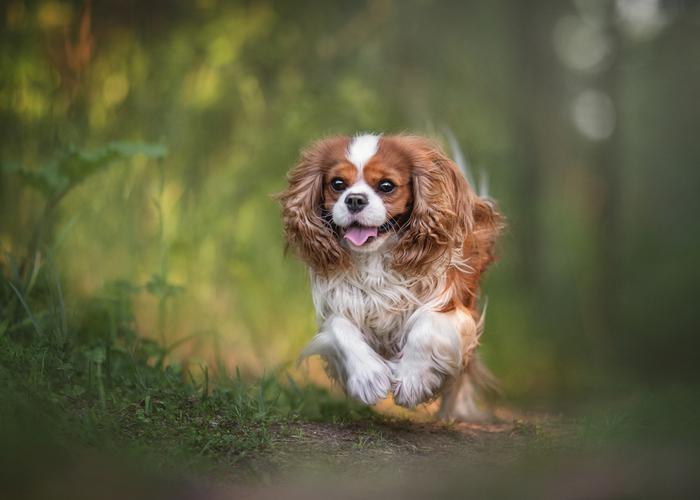
Cavalier King Charles Characteristics
Temperament for Cavalier King Charles Spaniel is not the aggressive type and is usually neutralist. Unless provoked, they are less likely to react to harmful stimulants.
They are pleasant, friendly, and submissive if trained well. They are also admirable in the presence of children.
Cavalier King Charles Spaniels are very much affectionate with their family. They show these through shared activities, playtime, and even just spending time doing about anything with them.
They are among the best fur companions at home, even when children are in your home or residence.
CKCS are very tolerable of children’s behavior. As observed, they are very gentle and playful around children.
If you have another fur companion in the household, CKCS is very adaptable to changes in the environment and welcomes other fur babies.
They are known for getting along well with other dogs.
CKCS’s social life is best for homes often visited in and out frequently by other people.
Although they have a protective nature but aren’t strictly vigilant, they’re very open to strangers as long as owners exhibit safety around the stranger.
Their adaptability level is satisfactory, as long as they are guided well by their owner as they are exposed to changes.
Mental stimulation is preferably given to them steadily with sufficient exposure to regular activities and attention to stimulate the dog’s growth skills and development.
The energy level is intermediate. They often show interest when initiated with playtime. They may also invite the owner to playtime every so often.
Cavalier King Charles Spaniel can be easily trained and are eager to please. The barking level is only vocal when they tend to be cautious or need the owner’s attention.
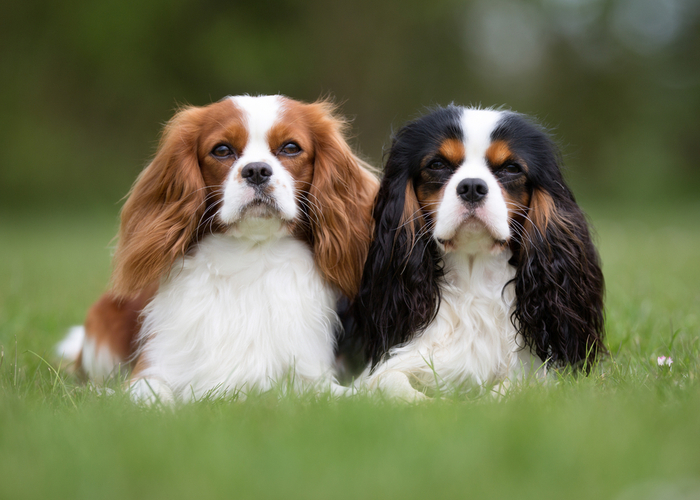
Cavalier King Charles Health and a Glimpse of History
Spaniel Breeds in the Kennel Club are bred to be hunt dogs or gundogs.
Breeding Spaniel phenotype into the current Cavalier King Charles Spaniel includes tracking down skills, pursuing a subject/ object or scent, and fetching activities.
Selecting breeding in domestic animals has brought genetic derangement to certain breeds. Sadly, Cavalier King Charles Spaniel is not an exemption.
Since breeding increases variety changes in the genotypes, disrupting normal development in animals.
Health imbalance has been inherited through this Kennel category.
Metabolic abnormalities, Neoplasia (excessive or abnormal growth of tissue in various areas), autoimmune diseases, and increased vulnerability to infection are included.
Studies have found that one of the most common types of diseases in Cavalier King Charles Spaniel is cardiovascular disease (heart murmur, congestive heart failure, leakage of blood from the damaged vulva, etc.).
Another common is a dermatological related disease, ocular, gastrointestinal, dental, and otitis related diseases. Most conditions appear earlier in male CKCS than four years of age and above.
Luckily, with the help of modern medicine, doctors are researching ways to assist our companions in overcoming these obstacles.
These challenges can be prevented and resolved with the help of our veterinarians and, of course, you as a companion!
Regular check-ups, keeping hygiene at pace, a healthy diet, and routine exercise or activities for your fur baby are a way to start.
Grooming a Cavalier King Charles Spaniel
Cavalier King Charles Spaniel has medium-length hair. The standard texture coats are silky and wavy.
Since their coat sheds moderately, it’s better to groom them as their new skin emerges. It requires twice/thrice a month to monthly grooming to maintain its coat health.
Often when a dog’s coat isn’t up to par, veterinarians advise supplements or vitamins to help attain them.
Furthermore, some dogs can be a bit anxious when grooming. It’s your job as the owner to help them relax. Space and treats can help them calm down during these times.
Cavalier King Charles Spaniel Exercise
Don’t be fooled by their diminutive nature. Cavalier King Charles Spaniel is bred as home companions, but their hunting and sportiness as Spaniels are still there.
To cater to their needs, we, as their companions/caretakers or owners, have provided a variety of playtime and activity to stimulate these kennels’ thirst for hunting and movement.
Here are some ideas you could do with your fur baby:
Training Basic Obedience
All dogs need mental stimulation to remain disciplined, entertained, and reassured.
Cavalier King Charles Spaniel needs it more as well, as their toy breed makes them the best lap dogs, their hunting instinct still needs to be given attention to.
Basic obedience training includes; sitting, standing, staying, speaking, lying down, yes or no, going home, and more.
To enable you to do these, you don’t need much materials and props on the first few pieces of training.
Container for treats cut treats into bite-size or pre-cut treats, their favorite toy, and a clicker (only when methods don’t work).
You’ll need to set up your area wherein there isn’t much distraction for your pet.
When you’re settled in, introduce your pet to the treatment or their favorite toy, give them a taste or two to see that they’ll be receiving these treats or toys from you.
Start with an easy obedience training such as sitting, including a specific hand gesture for that action, and keep repeating the word as they do the activity.
Whenever they successfully did the action asked, immediately after a second, reward them with the treat or their favorite toy.
Moreover, throw in some compliments to keep the energy of the training entertaining and positive for the two of you.
Positive reinforcement treats and compliments can help your dog process and understand that with a specific command, they must respond to receive these things.
It can also challenge them to spot the difference to remember the commands even more.
Make sure to keep your dog entertained and recognize their response, whether it’s positive or negative.
Scolding your dog isn’t always wrong as long as you’re doing the right way and the right reason, that comes with being a fur companion.
Cavalier King Charles Spaniels Agility Training
Cavalier King Charles Spaniels still has their hunting skills with them. As for their hunting skills, agility comes with it. Exercising this skill will keep your dog happy and entertained as well.
This can also be your exercise for the day!
You’ll need ample space and a toy rope or something close to it with this activity. Now introducing the toy rope wouldn’t be tricky, for they instantly interact with those.
But if your dog finds it a bit challenging, a little treat won’t hurt. If they have recognized the toy, try tugging it bit by bit when they’re biting into it.
Now try running a bit as they follow you with it. If they follow it, you’re closely getting to the activity. Now try running a bit faster as they chase the rope you’re holding.
Don’t forget to let them win by catching the rope once in a while. If they find it too challenging, they might give up on the activity altogether.
Now slowly introduce your dogs to obstacles to avoid getting bored with repetitive activities. You can try varieties of obstacles, such as something to jump on.
But remember, limit the time you do these activities with your pet. 5 minutes of warm-up to a 15 – 20 minute activity is enough.
Do not strain your dog as much as they are prone to orthopedic diseases.
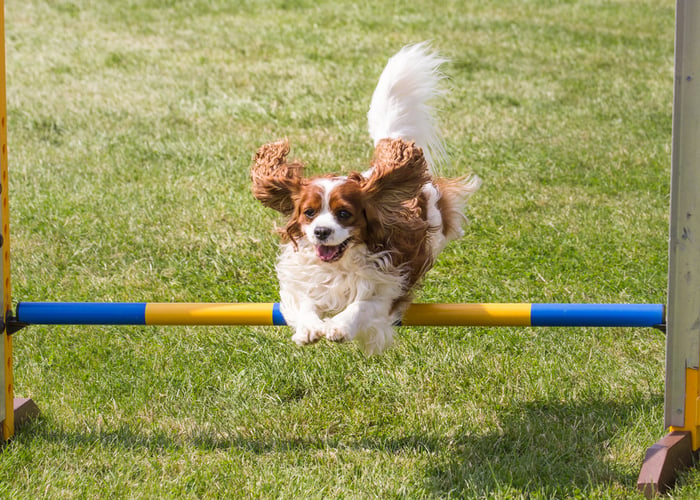
Daily Walks
Daily walks aren’t just an activity for dogs. It’s therapy! Walking involves exercise and using their scent around familiar and foreign things.
This can help them relax while enjoying and spending time with you.
Walking around to a nearby park, neighborhood, beach, or anywhere of your choice would be great for your dog. 10 – 20 minutes outside can stimulate your dog’s senses.
This can help them exercise their bones, muscles, senses, sociability, and alertness.
Furthermore, you, as an owner, of course, need to watch out for potential danger just in case of sudden events, but it is less likely to happen.
Traveling
Traveling is leisure to pets as well. Even if it’s just the mall, a park, a beach bringing your pet means spending time and experiencing life with them!
It’s not just a great exercise, but it can serve as bonding for your relationship as well.
Moreover, traveling can be stressful for other dogs. It’s your job to make them comfortable on your trip. You need to make sure that they’re safe and cozy when traveling.
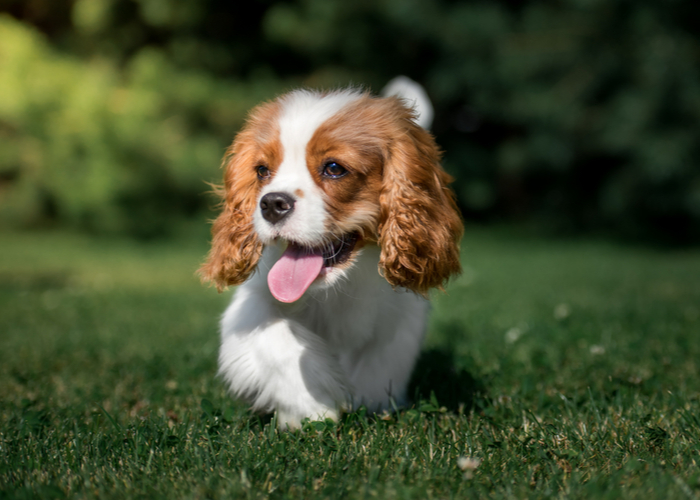
Where to Adopt a Cavalier King Charles Spaniel?
Always remember that owning a dog is not just a privilege; it’s a responsibility. And it’s always better to adopt rather than buy.
Adopting a dog is welcoming a new life in the family. It will not be cheap. The average price of a CKCS is around $1,500 to $2,500.
Moreover, you can always talk to breeders in your town. But always do your research if you want to have a healthy pup. Try visiting American Cavalier King Charles Spaniel Club, Inc., for breeder information.
Furthermore, adopting from rescue sites is still the best option. Here are a few places you can look for:
Cavalier King Charles Spaniels Dog Breed Conclusion
The Cavalier King Charles Spaniel is one of the most famous breeds. They are loving, adaptable, and loyal.
Being one of the most popular lap dogs comes with an adorable face and a friendly personality. A perfect pet for your kids and family.
They are an affectionate breed and a bit of an attention seeker, so be sure to have extra time to play with them. If you want a sweet dog, you can’t go wrong with choosing a Cavalier King Charles Spaniel.


